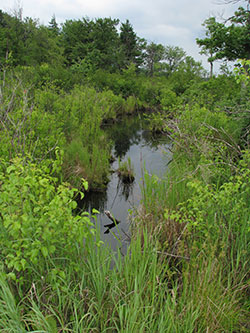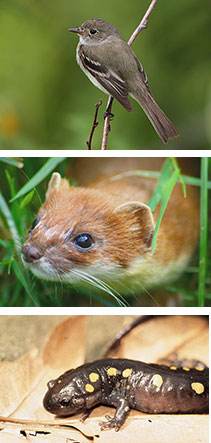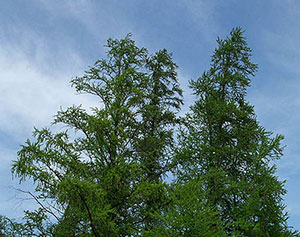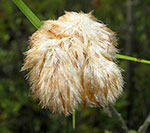Finzel Swamp, Garrett County
 Located at the headwaters of the Savage River, Finzel Swamp is a biodiversity treasure chest containing more than 30 rare and uncommon species, and five globally and locally significant wetland habitat types. This remnant boreal fen has been left behind from the Pleistocene Epoch and is one of the few remaining refuges in Maryland where boreal species have persisted since the last Ice Age. Nestled in a natural frost pocket, Finzel Swamp provides the colder conditions required for the survival of these species.
Located at the headwaters of the Savage River, Finzel Swamp is a biodiversity treasure chest containing more than 30 rare and uncommon species, and five globally and locally significant wetland habitat types. This remnant boreal fen has been left behind from the Pleistocene Epoch and is one of the few remaining refuges in Maryland where boreal species have persisted since the last Ice Age. Nestled in a natural frost pocket, Finzel Swamp provides the colder conditions required for the survival of these species.
 After a short hike from the parking lot through an alder thicket, the view opens to reveal the distinctive character of this location. Though hard to see without a pair of binoculars, Endangered American larch (Larix laricina) persist in the forested swamp to the north. In the spring, visitors may spot the rare alder flycatcher (Empidonax alnorum) swooping out from its perch to grab passing insects, or experience the annual spotted salamander migration. From the forested wetlands to the herbaceous wet meadows, these communities are all interconnected and support a variety of wildlife that utilize them for breeding, feeding and refuge.
After a short hike from the parking lot through an alder thicket, the view opens to reveal the distinctive character of this location. Though hard to see without a pair of binoculars, Endangered American larch (Larix laricina) persist in the forested swamp to the north. In the spring, visitors may spot the rare alder flycatcher (Empidonax alnorum) swooping out from its perch to grab passing insects, or experience the annual spotted salamander migration. From the forested wetlands to the herbaceous wet meadows, these communities are all interconnected and support a variety of wildlife that utilize them for breeding, feeding and refuge.
The trail leading from the parking area traverses the swamp, over a series of short wooden bridges, to a shallow lake. Along the trail, there are ample opportunities to observe many species of birds, butterflies, dragonflies and other wildlife and plants, some of which are rare or uncommon in Maryland. From the lake, visitors can continue north over a low hill that overlooks the eastern edge of the swamp. A few meadows dot the landscape further east and north. Finzel Swamp was established in 1970 and is owned and managed by The Nature Conservancy.
 Last Stand for Larch
Last Stand for Larch
While here, take a moment to look for the remaining American larch trees that still exist within the forested swamp to the north. These unusual conifers shed their needles in the winter after turning a brilliant golden-yellow in the fall. American larch has been lost at four locations in Maryland due to changes in climate as well as changes in natural water flow (hydrology). Currently, the population at Finzel Swamp is one of only two remaining populations in Maryland. In an attempt to save the larch from being lost at Finzel, The Nature Conservancy has worked tirelessly to restore the natural hydrology of this swamp.
 The Nature Conservancy Hard at Work
The Nature Conservancy Hard at Work
Finzel Swamp has been protected by The Nature Conservancy since the first tract was purchased in 1970. Eight additional tracts were added to this preserve in 1973. Management at this site has included a re-engineered road to allow a more natural water flow, forest regeneration and restoration, and an attempt to reduce ATV impacts.
 Click here for a Print Version of this map.
Click here for a Print Version of this map.
Finzel Swamp Natural Area
Directions
From Frederick: Take I-70 west to I-68 at Hancock. Continue on I-68 about 50 miles to Exit 29. Turn right at the end of the exit ramp, heading north toward Finzel on MD 546 (Beall School Road), and continue about 1.8 miles. Turn right onto Cranberry Swamp Road and keep left at the fork. Finzel Swamp is on the left. The parking area and trail head is at the end of the gravel/dirt road.

Driving directions and aerial views open with Google Maps. For the aerial view button, if an aerial view does not open by default, click on the Satellite icon in the upper right corner and Google Maps will switch to an aerial view of the Natural Area.
